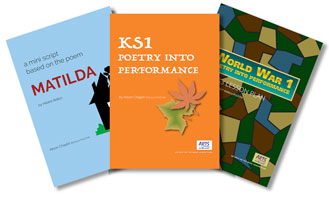DRAMA AND STUDENTS WITH SPECIAL NEEDS
Drama is often about collaboration and negotiation and when it is used in mixed-ability groups it can act as a bridge between children with special needs and others in their peer group. It can enable students with particular difficulties and provides an ideal environment to encourage students to work together and to develop trust and friendships.
There is, however, a danger of assuming that drama is 'the inclusion subject'. This can lead to:
- A devaluation of the contribution of theatre to academic work
- A devaluation of the achievements of all drama students
- The mis-teaching of drama as always accessible
- The perception of the arts as easy or not requiring basic skills
- The reduced perception of a subject at which some students with special needs can excel
- The alienation of special needs students who do not find drama lessons automatically accessible
None of these issues serve the student with special needs.
What if drama is difficult?
There are some students, and not only those with special needs, who will find some form of drama activities, or even the drama space itself, challenging. Non-classroom environments, group or pair work, performance, touch, open space, dialogues and self-expression can all present challenges. All of the well-known 'accessibility' techniques apply equally to drama: displays on the wall; a welcoming environment; a variety of activities and methods; art-based activities; writing together on large sheets of paper; employing costume, props and multimedia to support the work, and using both teacher- and student-led exercises.
Think about which activities will be challenging for students with special needs and aim to structure them tightly, in terms of classroom management and space, and also of transition into and out of them. It also helps not to present too many challenges at once, so try not to combine, for example, challenging group structures with work on a difficult issue. If an activity is difficult for some students, you can create safety nets or cushions, using drama techniques to help. These are discussed below.
Open space and the circle
Structure and careful classroom management can remedy some of the immediate shock of being in the open drama space. Working in a circle sets up a structure which can be constantly referred to and even maintained throughout the lesson. Or, in a traditional classroom, making a particular organised space by rearranging desks and chairs can help.
The use of the circle as a controlling device, although obviously much easier in a dedicated drama studio, is particularly good when members of a class have challenging behaviour or problems with social skills. It is also useful for students with a range of special needs. It occasionally presents a problem if one or two students are especially withdrawn, because everyone can be seen easily, so group trust needs to be developed at the same time as establishing the space, or the benefits of circle work will be stunted.
Some SEN students respond positively to the very open drama space and the possibilities it presents, so that the circle can be useful as a structured introduction to the opening out of space.
Developing the circle: a practical example
- Start the lesson in the circle and use games to establish both the circle space and turn-taking. If appropriate, talk about the use of the circle as a performance space and the history of the circle in theatre.
- Work on a whole group exercise, such as mime or rhythm, in which the idea of the circle and of turn-taking can be practised.
- Do some work in pairs or threes in the circle, seated or standing, re-establishing the circle at the end of each short activity.
- For demonstrations of work, go around the circle.
Once students have passed to less tightly structured work, the circle can still be useful:
- Use the circle to sit down in moments of confusion or noise.
- If you want to extend this and move into the rest of the drama space, establish the circle as a space to come back to and go away from for performance, discussion and demos.
- Introduce the use of other spaces gradually. Open up the space and make it available by starting with the circle.
- Experiment with other theatre spaces: traverse, end-on, open space, and so on.
'Now get into pairs!'
Another practical way in which some of these challenges can be met is through structured (rather than informal) group work. For example, use sustained pair work then join pairs together into groups, or play a game – such as Hotspot – which 'lands' students in pairs or groups. In a mixed-ability group, allow students to develop scenes which can be verbal or non-verbal and which can be developed to different levels by high-ability students and less able students.
Some group-work safety nets
- Regularly work in threes as well as in pairs, so that being in a group of three doesn't become stigmatised.
- Establish early on that the maths won't always work, so some people will be in a group of a larger or smaller number than that suggested, again to avoid stigma. (Depending on how the class is working together, it can be those who aren't as confident in the drama environment that end up in a group of three when the others are in pairs.)
- Use and value working individually as well as group work. Don't always end with group work.
- Allow observers, narrators, journalists, note-takers or cartoonists in some activities.
- Allow miming and gesture instead of dialogue in some activities.
- Use mixed-ability pairs, to allow the more able students to help their peers.
- Use activities where the roles in the group or pair are equally valued but unevenly weighted. For instance, in Hotseating activities, some students may find it easier to ask the questions especially if they have been prepared beforehand. If the more able student plays the character during Hotseating, it gives less able students an excellent demonstration of how the activity works.
Reading cushions
If basic skills are required in an activity, you can again use safety nets or cushions. Here are some reading cushions:
- Teach a line of dialogue using repetition and gesture before reading it.
- Read two lines of dialogue together as an introduction before going on to group work.
- Read a whole piece of text in mixed ability pairs or threes so that students can help each other.
- Create a wall display and an improvisation based on an aspect of the text before reading it. For instance, use a display of a street scene showing antagonism between two families, before learning two lines of the prologue to Romeo and Juliet using gestures and repetition, as an introduction to the play.
- Introduce other activities where students who find reading difficult will have their particular strengths championed and match these to reading activities.
The obvious benefit of drama is that it presents a chance for the student who struggles with literacy to flourish, though there shouldn't be a complete avoidance of reading and writing in favour of speaking and listening, especially as some students with special needs may be inclined to opt for the subject at GCSE, and from Key Stage 4, written work will be assessed. Care should be taken when introducing reading and writing activities if you have not experienced your students' level of literacy before.
Challenges that provide opportunities: self-expression and communication
Another important function of drama for students with special needs is in fostering the twin aims of self-expression and confidence-building; these are important tools in literacy-building, and a confident student is more likely to learn well and to enjoy learning in general. For students with challenging behaviour or problems interacting, drama provides an opportunity to let off energy within the boundaries of the lesson itself.
Drama also boosts the communication skills of students with special needs. Group negotiation and communication skills developed through drama can feed back into other subjects. It's worth bearing in mind that some students will find 'untaught' group work and communication skills hard, so don't make assumptions that certain things will come automatically. Drama makes an important contribution to the 'how to' of these skills.
Build the class up slowly in a structured way, gradually getting more complex, and practise communication techniques over several lessons. For instance, start with individual mime work, and move on to turn-taking games in pairs and in a whole group. Then try specific role-plays before using a freer kind of group improvisation. If these methods are repeated, the drama lesson will provide an opportunity to teach communication skills and group work rather than making certain students afraid of them.
Creating a group for students with special needs
A drama club or group especially for students with special needs will help you to concentrate on key activities and skills. It may prove better to have this club in the SENCO-run area rather than the drama studio, so that the environment is appropriate, classroom assistants are on hand to help and the SENCO can help set the agenda.
You may well have a specific aim in mind, but will probably also need to consider prioritising between group work, communication skills and confidence-building. An understanding of how to work on the basic drama skills should also be the focus, which can be taken away from the club and into the mixed-ability drama lesson. There are some key drama skills which need to be practised, for example: standing still (freezes and tableaux); sitting still and listening; watching; turn-taking; entering dialogues with confidence; making shapes; negotiating pairs and groups and building trust.
Resources:
Take a look at the drama games and drama methods listed on this site.
For additional ideas the resource pack Drama Methods and How to Use Them provides lots of great material.
For a simple but effective mime and sound performance, look at the KS1 Poetry Into Performance lesson plan.
For a more complex piece of drama work, that still allows students some autonomy with regards to personal response, look at the WW1 Poetry Into Performance lesson plan.
For a mini production in front of an audience the Matilda Mini Script works really well. This can be adapted for two or three strong readers, with the rest of your students miming the actions and reactions to the story.

For scripted pair work that can be explored as is, or developed further, try the Simple Script resource.
The Drama Games Compendium 1 contains 50 great drama games, many of which include variations providing loads of brilliant ideas.
Books:
- Special Talents, Special Needs: Drama for People with Learning Disabilities by Ian McCurrach and Barbara Darnley. Publ. Jessica Kingsley ISBN 978-1853025617
- Story Drama in the Special Needs Classroom: Step-by-Step Lesson Plans for Teaching Through Dramatic Play by Jessica Perich Carleton. Publ. Jessica Kingsley ISBN 978-1849058599
- 101 Games and Activities for Children With Autism, Asperger’s and Sensory Processing Disorders by Tara Delaney. Publ. McGraw-Hill Education ISBN 978-0071623360
- Drama Games for Those Who Like to Say No by Chris Johnston. Publ. Nick Hern Books ISBN 978-1848420496
Websites:
- NASEN The National Association of Special Educational Needs – the UK’s leading organisation for education professionals working with children and young people with special and additional needs and disabilities
- Dyspraxia Foundation Youth – provides support to young people that have Dyspraxia/DCD across the UK
- Chickenshed – an inclusive theatre company that uses the stage to celebrate diversity
- Children with special educational needs and disabilities (SEND) - Government web page
Magazines:
- SEN Magazine – features, news and articles covering all issues to do with SEN and disability




 This site uses cookies for tracking and statistical purposes. Please read our
This site uses cookies for tracking and statistical purposes. Please read our